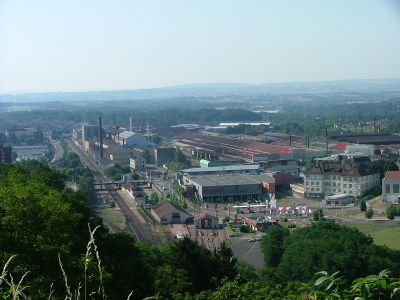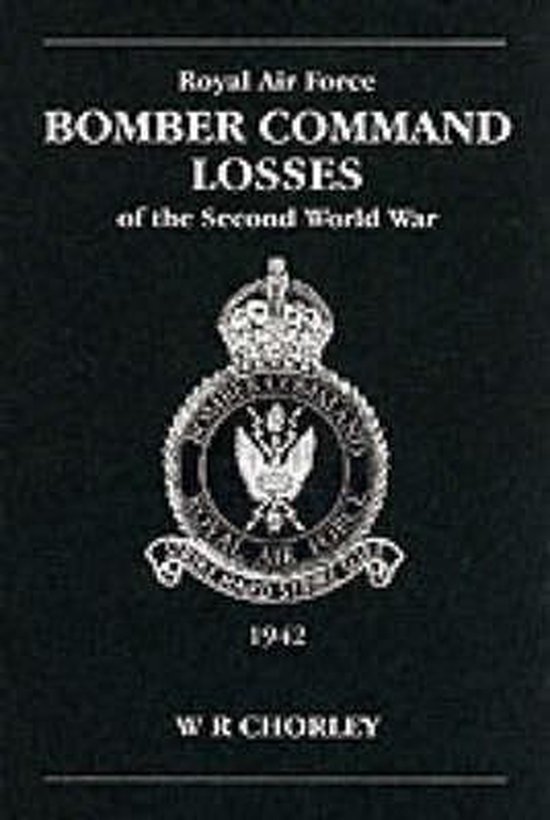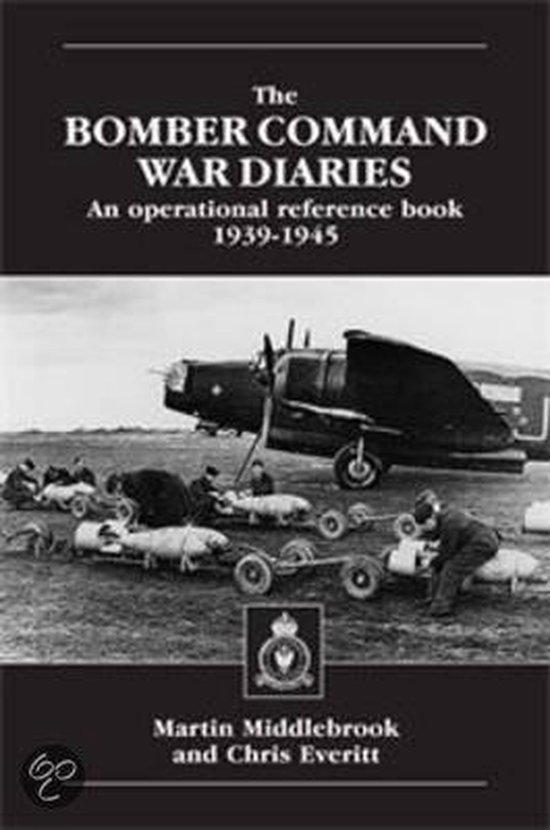Introduction
At the outbreak of World War II, RAF Bomber Command regularly carried out daylight operations. However it transpired quite soon that the British light bomber aircraft were extremely vulnerable at broad daylight. They were clearly visible by the enemy and they were not able to defend themselves effectively against the fast, agile and well-armed German fighters. Thus the losses were big during these missions. Consequently the choice was made to choose the cover of darkness for large scale bombardments. Bomber Command thereafter carried out only some large operations by daylight. One outstanding mission is the raid on the factories of Schneider in Le Creusot in the French Region of Burgundy. For this daring operation, which took place on the 17th of October, 1942, 94 Avro Lancaster bombers had to penetrate deeply into enemy air space and in broad daylight.
Definitielijst
- Bomber Command
- RAF unit which controlled strategic and sometimes tactical bombing (as in Normandy)
- RAF
- Royal Air Force. British air force
- raid
- Fast military raid in enemy territory
Images
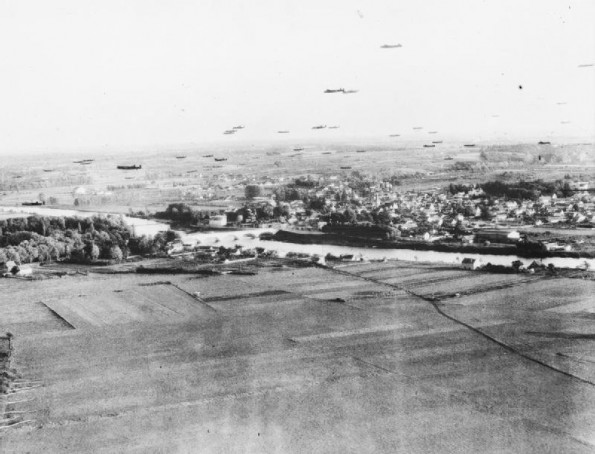 Avro Lancasters of No.5 Group flying over Montrichard. Source: Royal Air Force.
Avro Lancasters of No.5 Group flying over Montrichard. Source: Royal Air Force.An audacious plan of attack
Autumn 1942
During the winter of 1941 – 1942 Bomber Command found itself in a crisis. In the autumn of 1941 the Butt-report had been published. This analysis of the efficiency of the operations that were carried out by Bomber Command fuelled a discussion about the way the Bombers of the Royal Air Force were best applied. There were voices that promoted the limitation of the volume of Bomber Command and to allocate a more tactical and supporting role. The Chief of the Air Staff of the RAF, Air Chief Marshal Charles Portal however, did not wish Bomber Command to diminish its respect and to be (only) engaged in supporting other units of the forces. Therefor he appointed another commander, who had to generate a turn-around; Air Marshal Sir Arthur Harris was put in charge of Bomber Command. In order to quiet down the critics Harris needed a quick success. He wanted to impress the politicians and the public by carrying out a large scale attack. Herewith he would be able to demonstrate the power of Bomber Command. It was going to be an attack with more than one thousand bombers. The first "Thousand-Bomber Raid" took place during the night of 30 to 31 May, 1942. This air raid on Cologne received the code name Operation Millennium.
Even though the raid on Cologne was impressive, later issues of the "Thousand-Bomber Raids" were less successful. Harris did not succeed in silencing the criticism on Bomber Command completely. Even though new heavy bombers (Lancasters and Halifaxes) were made available to him and his flight crews could apply new navigation techniques (Gee and Oboe) there was no sign of structural improvement of the efficiency. Also losses kept increasing during the spring and summer of 1942 and the morale of the crews descended. The acute crisis had been survived, but the problems had not yet been solved. All this would cost time and in order to prevent the discussion about the engagement of Bomber Command to flare up again, Harris was in dear need of success.
An audacious plan of attack
This success Harris hoped to be able to achieve during a daring mission on 17 October, 1942. The target of the attack was the steel and weapon factory of Schneider in Le Creusot, a provincial French town. The Schneider brothers had established the factory in 1836 and had also specialized in the production of weaponry after the outbreak of the French-German war in 1870. The company built for example the first French armored tank, the Schneider CA1. During the Second World War the German occupying forces used the Schneider factory for the production of heavy guns. In Great Britain it was suspected that also tanks and armored vehicles were being built. The Schneider works were being considered to be the French equivalent of Krupp, the big German weapon manufacturer. For Bomber Command this was the most important target in France. However very close to the factory there was a large working-class housing quarter. For that reason they only wanted to carry out an attack when the weather conditions during the night were advantageous to such a degree that the chances to make civilian victims would be small.
Sir Arthur Harris devised an alternative plan of attack. He wanted to attack the factory during daylight and from low altitude. As described above, Bomber Command had actually started to avoid large scale daylight raids earlier during the war, as those were always accompanied by hefty losses. Like six months before, when an attack by daylight had been undertaken, but out of the twelve Lancasters that attacked on that day the MAN factories in Augsburg only five returned. Nevertheless Harris pursued his plan. No. 5 Group, under command of Air Vice Marshal Alec Coryton, was charged with this operation and started special training flights at low altitude. The, at that time, 10 years of age Martin Middlebrook (later on the British historian) was an eyewitness of one of those training flights: "I was out in a field near my house in Boston (Lincolnshire) gathering blackberries, when the amazing sight of nearly 100 Lancasters swept overhead".
The large formation of bombers had been deliberately chosen with a view to the defenses of the target. Although the Schneider works were the most important target for Bomber Command in France, the defense of the area was relatively weak. The Germans had only positioned twelve heavy anti-aircraft guns and thirty pieces of light artillery. Bomber Command did not want to run the risk that a small attack force would hardly damage the target which might at the same time call for a strong improvement of its defenses.
The attack was scheduled for Saturday 17 October, 1942. 88 Lancasters had to attack the buildings of the factory. 6 Lancasters had to bomb the nearby electric power station. This was located in Montchanin, a few miles further towards the east. Its transformers were being considered to be the most important exchange of the French electricity power net. It also provided the Schneider works with electrical power.
Definitielijst
- Bomber Command
- RAF unit which controlled strategic and sometimes tactical bombing (as in Normandy)
- Gee
- Allied radio guided navigation system to direct bombers to their intended targets.
- Krupp
- German family of steel and weapon’s manufacturers.
- Marshal
- Highest military rank, Army commander.
- Oboe
- Allied aerial blind bombing targeting system introduced early 1943, to guide bombers to their targets. Worked with echoes that were broadcast by the aircraft itself and therefore signals of the aircraft could be detected by the enemy. Worked by means of two ground stations, the CAT, which determined if the aircraft was flying on course and the MOUSE which indicated if the aircraft had arrived above target. Disadvantages were the limited range (270 miles) and the fact that the aircraft could be detected. Because of these disadvantages mainly Pathfinders Mosquito units used Oboe.
- RAF
- Royal Air Force. British air force
- Raid
- Fast military raid in enemy territory
Images
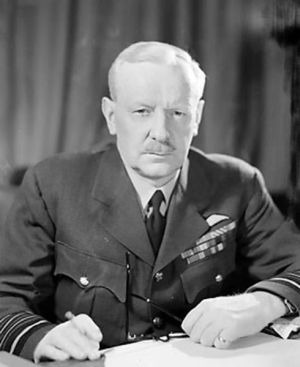 Air Chief Marshal Sir Arthur Harris, commander of Bomber Command. Source: Royal Air Force.
Air Chief Marshal Sir Arthur Harris, commander of Bomber Command. Source: Royal Air Force.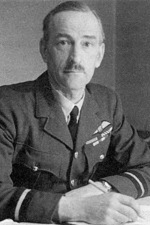 Air Vice Marshal Sir Alec Coryton. Source: Royal Air Force.
Air Vice Marshal Sir Alec Coryton. Source: Royal Air Force.The attack
For the composition of the attacking formation of 94 bombers Coryton called on all of his nine squadrons in 5 Group. The crews had intensively been trained for the mission, but until the evening before the attack, only Wing Commander Leonard Slee was informed about the target. He was in command of 49 Squadron and would be in charge of leading the attack. His attacking force was composed as follows:
9 Squadron – 10 Lancasters – RAF Bardney
44 Squadron – 9 Lancasters – RAF Waddington
49 Squadron – 10 Lancasters – RAF Scampton
50 Squadron – 12 Lancasters – RAF Skellingthorpe
57 Squadron – 10 Lancasters – RAF Scampton
61 Squadron – 7 Lancasters – RAF Systerson
97 Squadron – 9 Lancasters – RAF Coningsby
106 Squadron – 12 Lancasters – RAF Syerston
207 Squadron – 15 Lancasters – RAF Langar
In the morning of 17 October the crews were briefed about their mission. As the Lancasters were very vulnerable for attacking German fighter aircraft at daylight, maintaining secrecy was of the foremost importance. That’s why the crews after the briefing were neither allowed to leave their airfield anymore nor to have any contacts with the outside world. Also during the mission the use of their radios was prohibited. By flying very low, the Lancasters would be less conspicuous by the German radar system. Whitley bombers of Coastal Command flew fifteen minutes ahead of the Lancasters in order to attack possible German submarines and forcing them in this way to stay submerged, so they would not notice the Lancasters and signal warnings. Fighter Command and aircraft from Nr. 2 Group attacked targets along the French coast in order to distract attention.
After all crews had been briefed about the target of their mission, at 12:08 Slee was the first to take off. One by one the other squadrons completed the formation. The Lancasters headed in a loose formation across the sea in the direction of France. Between La Rochelle and St. Nazaire they entered France. Sergeant Green of 49 Squadron recalls: "All the way over there were Lancasters on each side of us, roaring at zero feet over France. Some of the French waved at us. It was a wonderful flight." All 880 miles to the target were flown without an escort of British fighters without any problem. The bombers were not attacked by German fighters. The only damage to four Lancasters was caused by bird strikes. Thereby also two crewmembers were slightly wounded. Thanks to good navigation work by Pilot Officer Grant, member of the crew of Wing Commander Slee, the formation reached Nevers. With green signal lights the other pilots were informed about obtaining this way point. From here the bombers started a climb out in order to achieve a safe altitude for the bombing runs.
Arriving over the target, the aircraft of Slee again emitted light signals. This time however with a red signal light. On the flanks aircraft from 9, 57 and 207 Squadron threatened to overtake Slee. A few moments later the Lancasters opened their bomb-bay doors. The German defenses were negligible so the pilots could easily and rather simply keep their machines on the right speed and altitude. The bombers dropped their load on the factory site. The crews observed some direct hits, for example Sergeant McIntyre: "No cloud in target area. Visibility good. Target seen clearly and our bombs burst on factory with excellent results." Also Sergeant Bonnett declared: "Bombs seen to burst bang on target." Flying Officer Gould: "Bombs seen to explode on factory buildings. Many large explosions with smoke obscuring area." The smoke clouds were responsible for the fact that the aircraft in the rear of the formation could not clearly distinguish their target. The tail gunner of one of these Lancasters was shocked when he saw that the first bombs of his aircraft for the factory landed between the houses of the French workers. However nothing has become known about any civilian victims during this raid. The absence of any German fighters and the negligible defenses at the factory indicate that the enemy was totally surprised by this attack. Only a few aircraft were slightly damaged by anti-aircraft guns or by hits from hand guns. The whole raid on the Schneider works had only lasted for seven minutes.
Of the formation of six Lancasters that attacked the power station two aircraft were from 106 Squadron. They were flown by Wing Commander Guy Gibson and Flight Lieutenant John Hopgood, two men who would participate half a year later in the famous raid on the dams in the Ruhr valley (Operation Chastise). The Lancasters all carried a load of ten bombs of 500 pounds. After the bombs had been discharged the aircraft circled one more time over their target, to enable the gunners to also fire at the power station. Every direct hit was accompanied by bright blue flashes. The small formation succeeded in destroying the power station, but in doing so they lost one bomber. That was Lancaster W4774 of 61 Squadron, piloted by Squadron Leader William Corr. It carried out its attack on the power station at Montchanin from very low altitude and crashed into a building. Six of the seven crew lost their lives. Sergeant Turtle survived the crash and was taken prisoner of war. The aircraft of Hopgood became damaged by the explosions of her own bombs as she was flying too low when dropping them. He could however reach England without great difficulties.
In spite of bad weather over England the remainder of the formation was also able to return safely. Over half of the aircraft was forced to land however on airfields in the south. One Lancaster of 207 Squadron had a very difficult return flight. The pilot, Sergeant Wilson had to run on three engines only. Over the sea the crippled aircraft was even attacked by three German Arado 196 seaplanes. During the third attack the Flight Engineer was killed. The gunners of the Lancaster however succeeded in downing two of the enemy planes and to damage the third which terminated the attack. The Lancaster finally achieved reaching RAF Langar in Nottinghamshire. The crew was awarded the Distinguished Flying Medal.
Definitielijst
- radar
- English abbreviation meaning: Radio Detection And Ranging. System to detect the presence, distance, speed and direction of an object, such as ships and airplanes, using electromagnetic waves.
- RAF
- Royal Air Force. British air force
- raid
- Fast military raid in enemy territory
Images
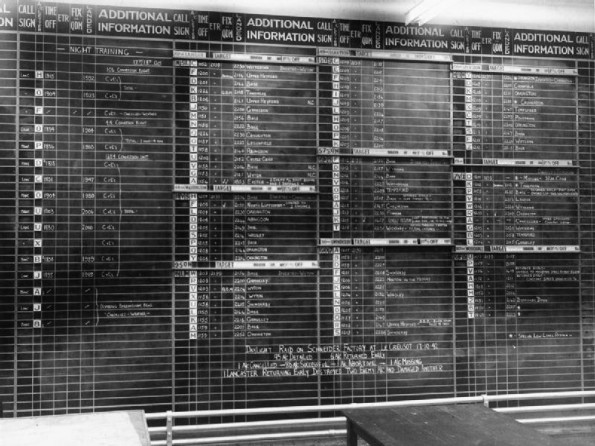 The operations blackboard before the attack on Le Creusot Source: Royal Air Force.
The operations blackboard before the attack on Le Creusot Source: Royal Air Force.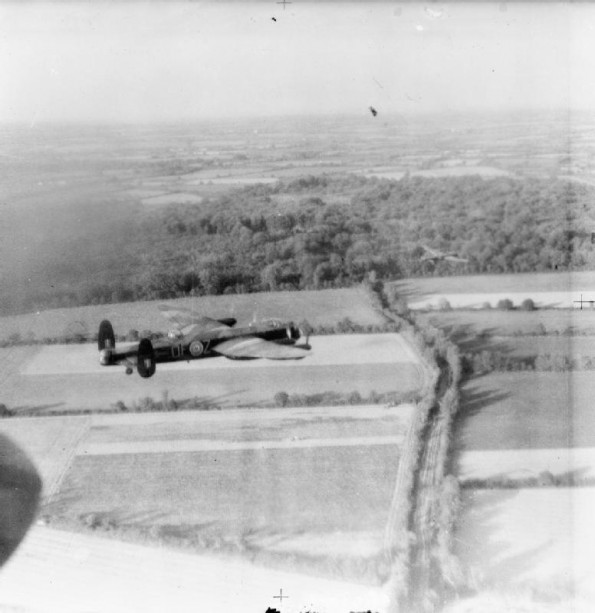 Lancaster of No.5 Group on its way to the Schneider factories. Source: Royal Air Force.
Lancaster of No.5 Group on its way to the Schneider factories. Source: Royal Air Force.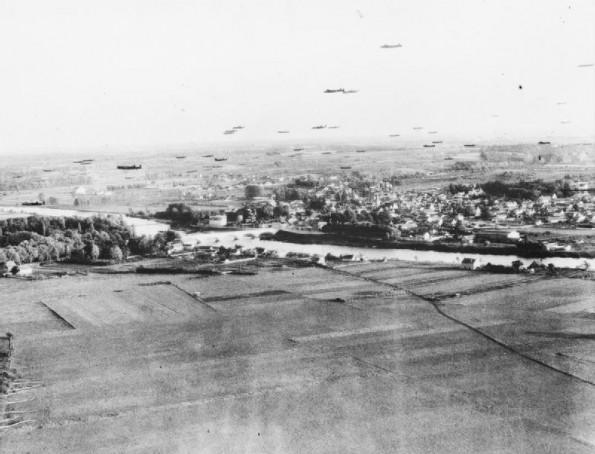 Lancasters of No.5 Group flying over Montrichard. Source: Royal Air Force.
Lancasters of No.5 Group flying over Montrichard. Source: Royal Air Force.Aftermath
According to the crews of the Lancasters the attack was successful. However, a year before, an independent investigation of the results of bomb raids (the afore mentioned Butt-report) had pointed out that one could not dedicate ponderous conclusions to the observations of the flight crews themselves. Therefore it was usual that photographs were made by the RAF. The timing of the attack on Le Creusot had prevented this. It was already too dark to make daylight pictures and it was still too bright for night pictures. So in the days after the attack, reconnaissance flights were made. Together with intelligence reports these pictures confirmed that the raid had been successful. Most of the damage was done to the rolling mills, the forgeries and the shop where the armored plating was bent. Also the shops where locomotives and engines were manufactured had been receiving direct hits. Here, large sections of the buildings had collapsed. The conclusion was drawn that the production of this very important weapon manufacturer had been interrupted for an important span of time by the attack.
The results of the bomb raid on the nearby electricity power station were also satisfactory. The central part had been completely destroyed. Finally it would take over two years to repair the transformers and to restart the production of electricity.
The day after the attack, the flight crews had already received a message of the commander of Bomber Command Air Vice Marshal Sir Arthur Harris: "Congratulations to all concerned yesterday’s brilliantly executed and highly successful operation. In less than five minutes at the cost of one aircraft missing to at least two enemy aircraft destroyed, you have deprived the enemy of one of his major sources of armament supply. The timing and navigation to within one minute and less than one mile over a source of 2,000 miles and the landing of nearly 100 aircraft in darkness under bad weather conditions on strange bases without bending a rivet, evidence a standard of airmanship throughout your command which has yet to be surpassed." The flight crews also received congratulations from the commanders of No.5 and No.9 Group, Coastal Command and from Roy Chadwick, the designer of the Avro Lancaster.
After the raids on Augsburg and Dantzig, the attack on Le Creusot was the third daylight operation in 1942 by No.5 Group. Exactly one week later, on 24 October, another attack in broad daylight followed. This time the target was Milan. The experiences gained with these raids, must have had a great impact on the planning and carrying out of the famous attack on the dams in the Ruhr river in May 1943. Also these were carried out by No.5 Group. The therefore composed 617 Squadron existed out of especially selected pilots. Fourteen of them, amongst whom Guy Gibson, had already also participated over half a year before, in the attacking force of the raid on Le Creusot.
Definitielijst
- Bomber Command
- RAF unit which controlled strategic and sometimes tactical bombing (as in Normandy)
- Marshal
- Highest military rank, Army commander.
- RAF
- Royal Air Force. British air force
- raid
- Fast military raid in enemy territory
Images
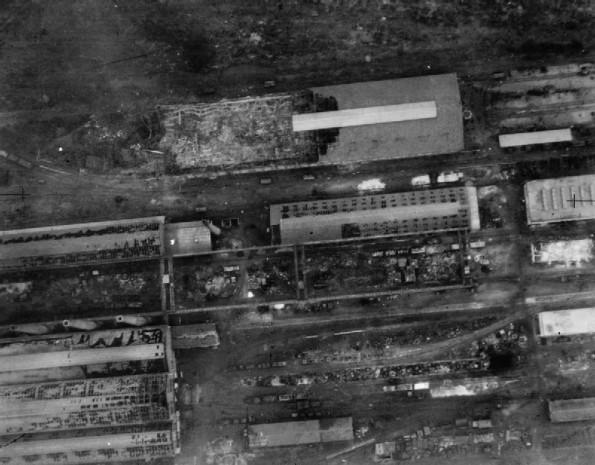 Reconnaissance picture after the bomb raid. Source: Royal Air Force.
Reconnaissance picture after the bomb raid. Source: Royal Air Force.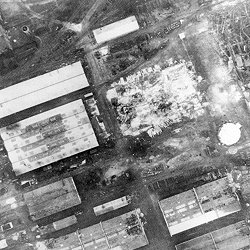 Reconnaissance picture after the bomb raid. Source: Royal Air Force.
Reconnaissance picture after the bomb raid. Source: Royal Air Force.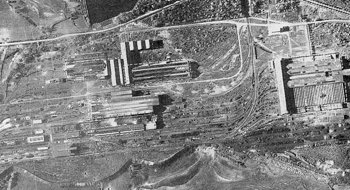 Reconnaissance picture after the bomb raid. Source: Royal Air Force.
Reconnaissance picture after the bomb raid. Source: Royal Air Force.Information
- Article by:
- Pieter Schlebaum
- Translated by:
- Fred Bolle
- Published on:
- 30-10-2013
- Last edit on:
- 30-09-2024
- Feedback?
- Send it!
- 11-'46: No. 35 Squadron
The War Illustrated
Related books
Sources
- CHORLEY, W.R., RAF Bomber Command Losses of the Second World War, 1942, Ian Allan Publishing, 1998.
- LAWRENCE, W., No5 Bomber Group RAF, Faber & Faber, Londen, 1951.
- MIDDLEBROOK, M. & EVERITT, C., The Bomber Command War Diaries, Midland Publishing, 2011.
61 Squadron Operations Record Book October 1942
97 Squadron Operations Record Book October 1942
106 Squadron Operations Record Book October 1942
Report by Sergeant Tom Bonnett (49 Squadron)
